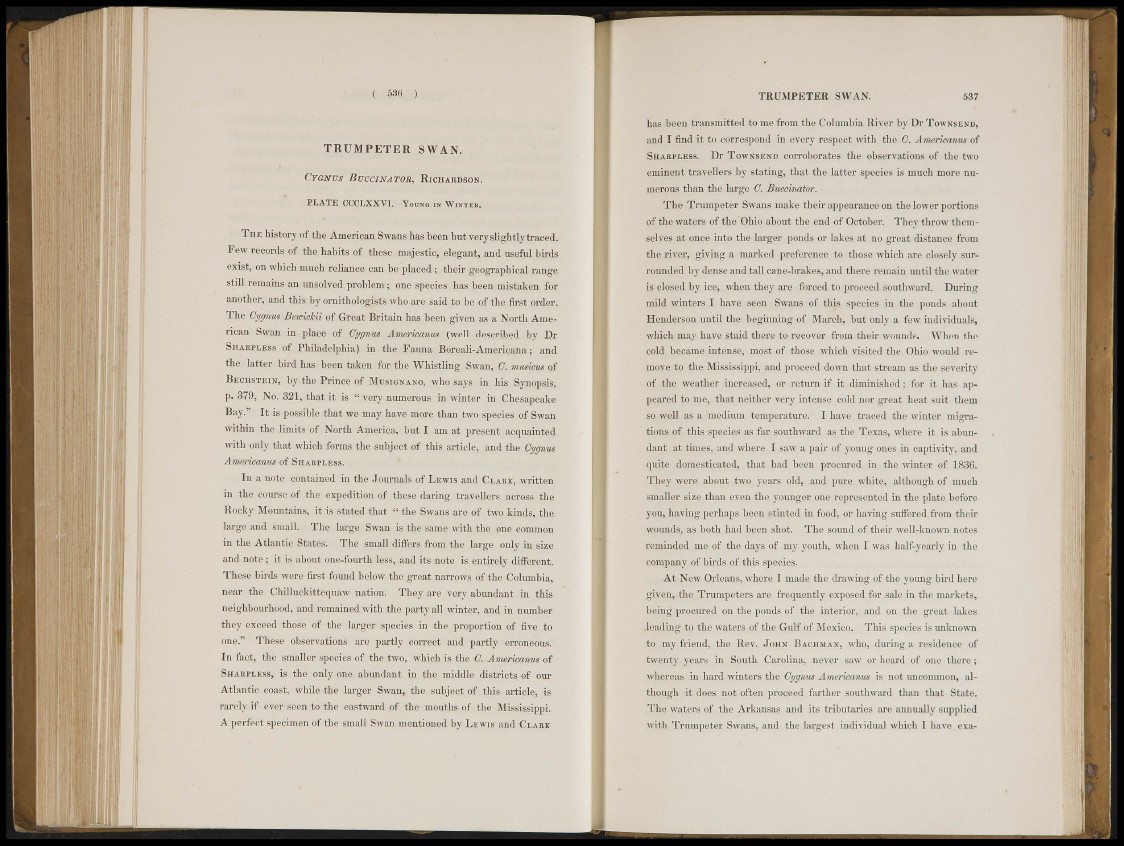
I ™
T R U M P E T E R SWAN.
CYGNUS BUCCINATOR, RICHARDSON.
P L A T E CCCLXXYI. YOUN® IN WINTER.
THE history of the American Swans has been but very slightly traced.
Few records of the habits of these majestic, elegant, and useful birds
exist, on which much reliance can be placed ; their geographical range
still remains an unsolved problem ; one species has been mistaken for
another, and this by ornithologists who are said to be of the first order.
The Cygnus BemcJcii of Great Britain has been given as a North American
Swan in place of Cygnus Americanus (well described by Dr
SHARPLESS of Philadelphia) in the Fauna Boreali-Americana ; and
the latter bird has been taken for the Whistling Swan, . <7. musicus of
BECHSTEIN, by the Prince of MUSIGNANO, who says . in his Synopsis,
P' 379, No. 321, that it is " very numerous in winter in Chesapeake
Bay." It is possible that we may have more than two species of Swan
within the limits of North America, but I am at present acquainted
with only that which forms the subject of this article, and the Cygnus
Americanus of SHARPLESS.
In a note contained in the Journals of LEWIS and CLARK, written
in the course of the expedition of these daring travellers across the
Rocky Mountains, it is stated that " the Swans are of two kinds, the
large and small. The large Swan is the same with the one common
in the Atlantic States. The small differs from the large only in size
and note ; it is about one-fourth lesss, and its note is entirely different.
These birds were first found below the great narrows of the Columbia,
near the Chilluckittequaw nation. They are very abundant in this
neighbourhood, and remained with the party all winter, and in number
they exceed those of the larger species in the proportion of five to
one." These observations are partly correct and partly erroneous.
In fact, the smaller species of the two, which is the C. Americanus of
SHARPLESS, is the only one abundant in the middle districts of our
Atlantic coast, while the larger Swan, the subject of this article, is
rarely if ever seen to the eastward of the mouths of the Mississippi.
A perfect specimen of the small Swan mentioned by LEWI S and CLARK
T R U M P E T E R SWAN. 537
has been transmitted to me from the Columbia River by Dr TOWNSEND,
and I find it to correspond in every respect with the C. Americanus of
SHARPLESS. Dr TOWNSEND corroborates the observations of the two
eminent travellers by stating, that the latter species is much more numerous
than the large C. Buccmator.
The Trumpeter Swans make their appearance on the lower portions
of the waters of the "Ohio about the end of October. They throw themselves
at once into the larger ponds or lakes at no great distance from
the river, giving a marked preference to those which are closely surrounded
by dense and tall cane-brakes, and there remain until the water
is closed by ice, when they are forced to proceed southward. During
mild winters I have seen Swans of this species in the ponds about
Henderson until the. beginning of March, but only a few individuals,
which may have staid there to recover from their wounds. When the
cold became intense, most of those which visited the Ohio would remove
to the Mississippi, and proceed down that stream as the severity
of the weather increased, or return if it diminished ; for it has appeared
to me, that neither very intense cold nor great heat suit them
so well as a medium temperature. I have traced the winter migrations
of this species as far southward as the Texas, where it is abundant
at times, and where I saw a pair of young ones in captivity, and
quite domesticated, that had been procured in the winter of 1836.
They were about two years old, and pure white, although of much
smaller size than even the younger one represented in the plate before
you, having perhaps been stinted in food, or having suffered from their
wounds, as both had been shot. The sound of their well-known notes
reminded me of the days of my youth, when I was half-yearly in the
company of birds of this species-
At New Orleans, where I made the drawing of the young bird here
given, the Trumpeters are frequently exposed for sale in the markets,
being procured on the ponds of the interior, and on the great lakes
.leading to the waters of the Gulf of Mexico. This species is unknown
to my friend, the Rev. JOHN BACHMAN, who, during a residence of
twenty years in South Carolina, never saw or heard of one there ;
whereas in hard winters the Cygnus Americanus is not uncommon, although
it does not often proceed farther southward than that State.
The waters of the Arkansas and its tributaries are annually supplied
with Trumpeter Swans, and the largest individual which I have exa